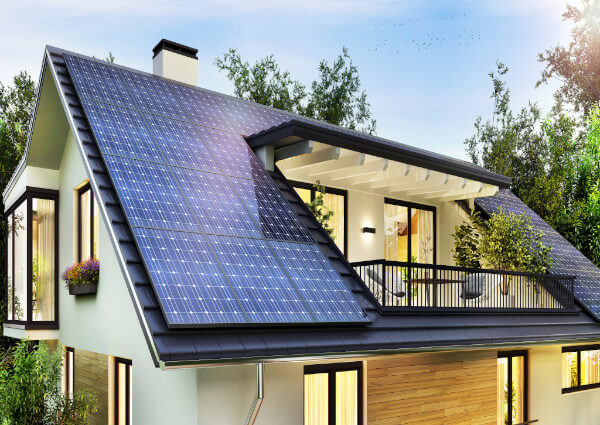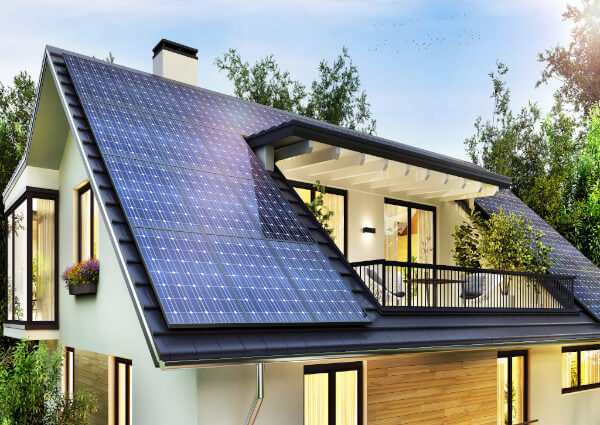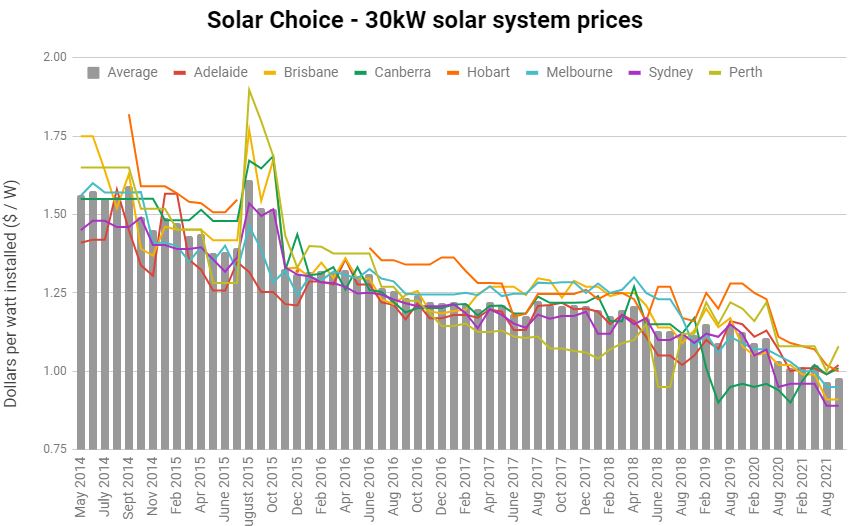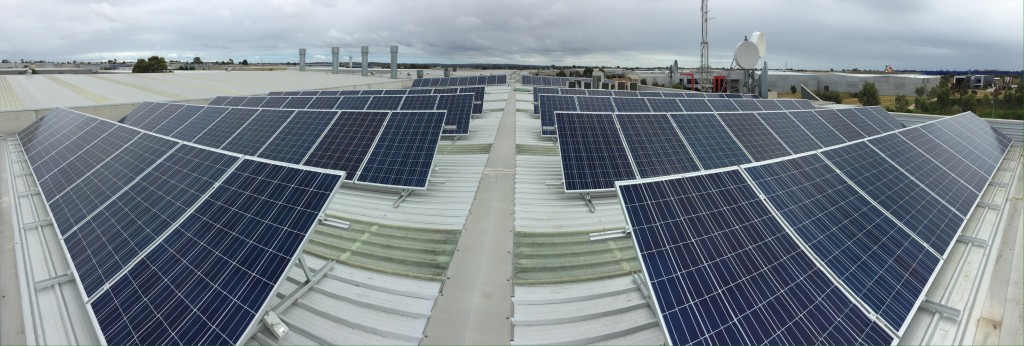30kW Commercial Solar: Pricing, Output, and Returns


30kW solar power systems are becoming an increasingly worthwhile and attractive investment for small to medium businesses across Australia, with payback periods in the 3-5 year range in most parts of the country. This article provides an overview of the ranges of prices, energy yields (in kWh), and financial returns that a business may expect to see from a typical 30kW solar PV system.
How much does a 30kW solar system cost?
The cost of small-scale commercial solar systems has fallen dramatically in Australia over the last few years, thanks to decreasing technology costs and the STC government incentive scheme for systems under 100kW in output capacity.
Since May 2014, Solar Choice has been publishing average solar PV system prices for solar systems from 10kW to 100kW via the Commercial Solar PV Price Index. On average a fully installed 30kW system will cost roughly $30,030 as of November 2021. These figures inclusive of the government incentive (STCs) and GST.
The table below shows the history of average prices for 30kW Solar PV systems by capital city:

Request a free solar business case and compare leading commercial installers
Get Started NowOver 3,000 businesses have trusted Solar Choice
Step 1 of 2
50%CommercialIs MobileBusiness NameDo you know what size system you would like to install?Under 30kw30 to 100kW100 to 1MWOver 1MWNot sureWhat stage are you at with your investigations?Just getting startedAlready done some research into solarReceived Quotes AlreadyWhat is the address of the proposed installation?This information is used to identify your roof and the local pre-vetted installers to include in your online quote comparison.Full AddressAddress Line 1CityNSWVICACTNTQLDSATASWAStatePostcodeContact NameEmail AddressPhone NumberUpload a recent power bill (optional)Drop files here or Accepted file types: pdf.Affiliate CodeStatsNameThis field is for validation purposes and should be left unchanged.jQuery(document).ready(function($){gformInitSpinner( 34, ‘https://www.solarchoice.net.au/wp-content/themes/solarchoice/img/btn-ajax-loader.gif’ );jQuery(‘#gform_ajax_frame_34’).on(‘load’,function(){var contents = jQuery(this).contents().find(‘*’).html();var is_postback = contents.indexOf(‘GF_AJAX_POSTBACK’) >= 0;if(!is_postback){return;}var form_content = jQuery(this).contents().find(‘#gform_wrapper_34’);var is_confirmation = jQuery(this).contents().find(‘#gform_confirmation_wrapper_34’).length > 0;var is_redirect = contents.indexOf(‘gformRedirect(){‘) >= 0;var is_form = form_content.length > 0 && ! is_redirect && ! is_confirmation;var mt = parseInt(jQuery(‘html’).css(‘margin-top’), 10) + parseInt(jQuery(‘body’).css(‘margin-top’), 10) + 100;if(is_form){jQuery(‘#gform_wrapper_34’).html(form_content.html());if(form_content.hasClass(‘gform_validation_error’)){jQuery(‘#gform_wrapper_34’).addClass(‘gform_validation_error’);} else {jQuery(‘#gform_wrapper_34’).removeClass(‘gform_validation_error’);}setTimeout( function() { /* delay the scroll by 50 milliseconds to fix a bug in chrome */ }, 50 );if(window[‘gformInitDatepicker’]) {gformInitDatepicker();}if(window[‘gformInitPriceFields’]) {gformInitPriceFields();}var current_page = jQuery(‘#gform_source_page_number_34’).val();gformInitSpinner( 34, ‘https://www.solarchoice.net.au/wp-content/themes/solarchoice/img/btn-ajax-loader.gif’ );jQuery(document).trigger(‘gform_page_loaded’, [34, current_page]);window[‘gf_submitting_34’] = false;}else if(!is_redirect){var confirmation_content = jQuery(this).contents().find(‘.GF_AJAX_POSTBACK’).html();if(!confirmation_content){confirmation_content = contents;}setTimeout(function(){jQuery(‘#gform_wrapper_34’).replaceWith(confirmation_content);jQuery(document).trigger(‘gform_confirmation_loaded’, [34]);window[‘gf_submitting_34’] = false;}, 50);}else{jQuery(‘#gform_34’).append(contents);if(window[‘gformRedirect’]) {gformRedirect();}}jQuery(document).trigger(‘gform_post_render’, [34, current_page]);} );} ); jQuery(document).bind(‘gform_post_render’, function(event, formId, currentPage){if(formId == 34) {} } );jQuery(document).bind(‘gform_post_conditional_logic’, function(event, formId, fields, isInit){} ); jQuery(document).ready(function(){jQuery(document).trigger(‘gform_post_render’, [34, 1]) } );
How much energy will a 30kW solar system produce?

Depending on a number of factors, the actual power output of a 30kW solar power system will vary. These variables include:
Geographical location of the system and the expected daily and annual solar irradiation and cloud cover levels thereOrientation and tilt angle of the solar panel arrayWhether there is any shade cast on the panelsActual operating temperature of the panels
The table below provides a rough indication of the amount of energy that a 30kW solar system will produce per day (averaged over the year) in Australia’s capital cities.
30kW Solar System Energy Output
Capital CityApprox average daily energy production*Adelaide109-122kWhBrisbane116-122kWhCanberra108-124kWhDarwin130-136kWhHobart86-99kWhMelbourne94-108kWhPerth120-131kWhSydney102-113kWh*Assumes north-facing with no shading, 75% system efficiency. Information via PVWatts & Bureau of Meteorology
Keep in mind that the figures in this table are annual averages – daily output figures will generally be higher in the summer and lower in the winter due to the difference in the length of days. In the winter, a system may generate 20-40% less energy, while in the summer it may generate 20-40% more.
Is 30kW the right solar system size for your business?
Determining the right size solar system for your business essentially comes down to three factors:
Roof space available: A 30kW system will require at least roughly 150-200m2 of area, but possibly more depending on the wattage of the panels and whether the they require tilt frames.Your energy consumption habits: In many places in Australia, solar feed-in credits are not paid out for energy sent into the grid by solar systems over 10kW in capacity; this means that any solar energy that your system produces that you cannot use directly is of no financial benefit to you. Solar Choice’s engineers can independently assess your solar needs and develop a business case for you at no cost – click here.Your budget: If you have enough roof space to install the maximum recommended solar system size, then it comes down to whether you have the budget to invest in a system.
What is the typical ROI and payback period for a 30kW solar system?
According to our own data from nearly 300 business cases compiled in 2021, payback periods for appropriately sized commercial-scale solar systems in Australia are around 2 years on average. This factors in both the government STC rebate and the current tax incentives for depreciating solar systems.
Request a free solar business case and compare leading commercial installers
Since 2008 Solar Choice has consulted with over 3,000 businesses around Australia and helped develop over 800MW solar commercial and solar farm projects.
Get Started Now
© 2019 Solar Choice Pty Ltd
The post 30kW Commercial Solar: Pricing, Output, and Returns appeared first on Solar Choice.

